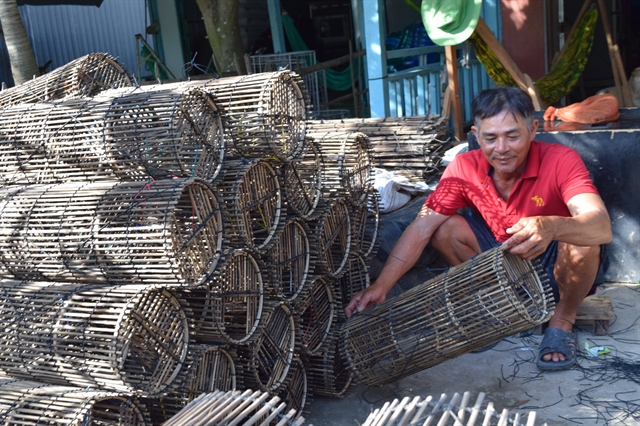 Society
Society

Farmers in the Cửu Long (Mekong) Delta’s upstream areas are waiting for the flood season, which brings sediment to rice fields and other areas of aquatic resources.

|
| The Bình Thạnh crab-catching tool making village in Đồng Tháp Province’s Hồng Ngự District. — VNA/VNS Photo Chương Đài |
ĐỒNG THÁP — Farmers in the Cửu Long (Mekong) Delta’s upstream areas are waiting for the flood season, which brings sediment to rice fields and other areas of aquatic resources.
The delta’s flood season normally occurs between August and November, but this year floodwaters caused by the rising level of the Mekong River in the rainy season have not appeared in many rice fields in upstream areas.
In Đồng Tháp Province’s Hồng Ngự District, the first locality which usually floods, farmers are opening more than 9,000ha of rice fields to wait for floodwaters.
The district has decided to not grow the autumn-winter rice crop, the year’s third rice crop, on more than 9,000ha of rice fields and will release floodwater into the fields to fertilise the soil and destroy pathogens and pests.
Nguyễn Văn Học in the district’s Thường Thới Hậu A Commune said that after harvesting the summer-autumn rice, he did not grow the autumn-winter and is preparing to receive floodwaters for his field.
He ploughed his rice field so that it will absorb sediments when the field receives floodwater. However, the level of floodwater is low now and has not entered his field.
If low floodwaters cannot enter the field, the next winter-spring rice will be affected because wild grasses, pathogens and pests still exist in the field, Học said.
In addition, the production cost of the winter-spring rice will be high because the field has not been fertilised by flood sediments.
The delta’s flood season is expected to come late this year because of low rainfall, and will be weaker than normal.
The flood season is estimated to reach its peak at the end of this month and be 0.2 – 0.4 metre lower than the average level of many years, according to the National Centre for Hydro-Meteorology Forecasting.
Floodwaters are now appearing in some upstream areas in Đồng Tháp and An Giang provinces. Farmers who catch fish and other aquatic species are also waiting for the rising of floodwaters since big floods offer more fish and other natural resources.
Nguyễn Văn Đoàn, who has earned a living from catching mud crabs in Đồng Tháp’s Hồng Ngự District for 15 years, said the number of mud crabs had declined significantly in recent years, especially in years when there are small floods.
He now catches only 13 – 14 kilogramme of crabs every two days.
Fishing tool production
Villages that make tools for catching fish and other aquatic species in the delta have entered their production period for the flooding season, but their operations are not busy as in previous years.
The villages include the Rơm Thơm fishing net-making village in Cần Thơ City’s Thốt Nốt District, Lai Vung fishing net-making village in Đồng Tháp’s Lai Vung District and Bình Thạnh crab-catching tool making village in Đồng Tháp’s Hồng Ngự District.
Bình Thạnh produces crab-catching tools year round, but its busiest production time is during the flooding season.
Nguyễn Văn Ghi, whose establishment makes crab-catching tools in Bình Thạnh for more than 20 years, said he normally made 4,000 of these tools each year in previous years.
However, he only makes about 2,000 crab catching tools this year because of small floods.
This year, floodwaters had occurred late and were low, so catching fish and other aquatic species in the flood season in upstream areas had just started, he said.
“The sales of fish-catching tools are lower than in previous years,” he said.
Crab-catching tools made from bamboo are selling at a price of VNĐ27,000 (US$1.2) each, and producers can earn a profit of VNĐ8,000 – 10,000 for each, according to producers.
Bình Thạnh’s crab-catching tools are sold in the province and neighbouring province of Long An and are also exported to Cambodia.
The village has nearly 100 households making crab-catching tools.– VNS




